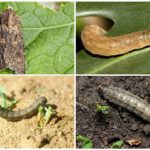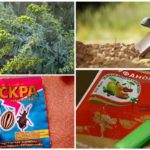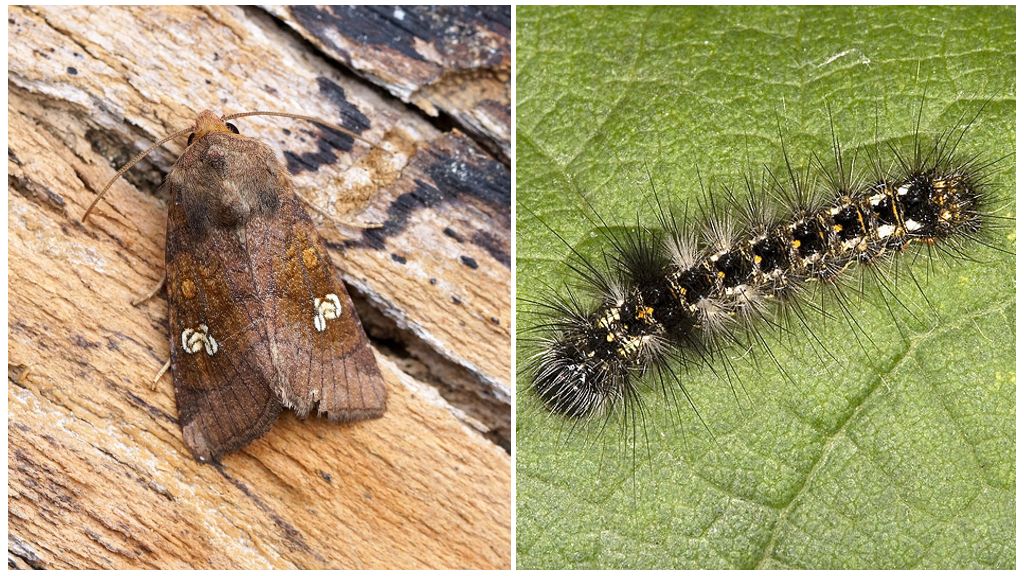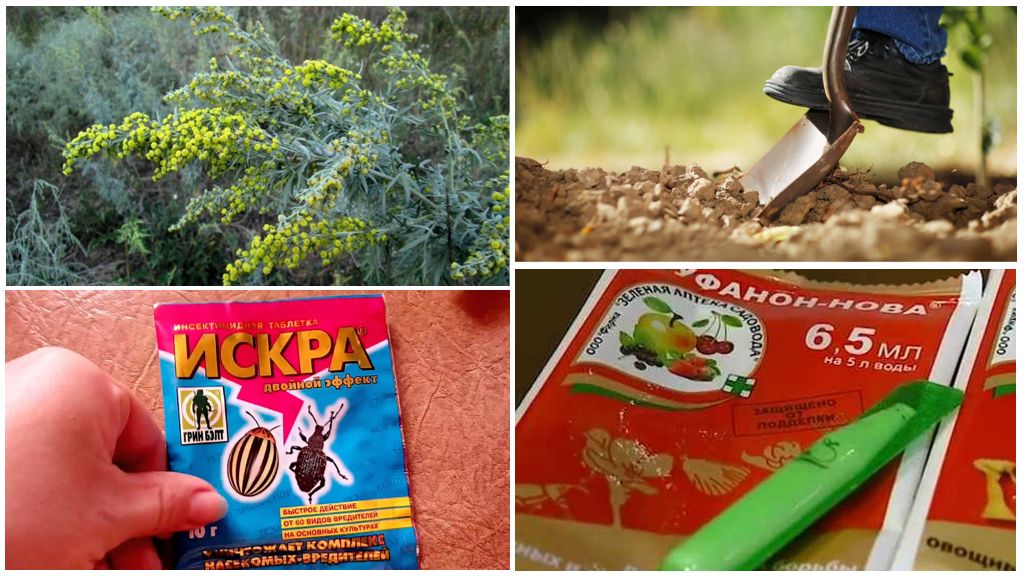Description and photo of butterflies and caterpillars scoops how to fight
Content
- Butterfly and caterpillar scoops
- Caterpillars scoops
- Caterpillar Fighting Measures
The scoop caterpillar is a fruit pest and a threat to the future harvest, eating leaves and buds on trees and shrubs. It is so tenacious that it can survive even in the tropics and the Arctic desert. Only effective measures to combat the scoop at all stages of its development will help protect garden crops from damage.
Description of butterflies and caterpillars
Scoops are flying insects, in appearance resembling a gray mole. The greatest harm to plants is brought by its caterpillars, which are so voracious and insatiable, that in a few days they are able to deprive a tree or shrub of all green parts. They live in the soil, and find food for themselves, climbing the trunk and branches of garden crops.
In total, a large number of such butterflies are widespread in the world, the main ones are: cabbage, garden, pea, gamma, winter, exclamation and gnawing.
Caterpillars scoops can reach lengths of 4-5 cm. Medium development period from egg to imago 1 month. Larvae hatch after 4-10 days from eggs laid by the female. During its existence for 14–20 days, the caterpillar actively feeds and grows, surviving 5–6 age generations and shedding 3-5 times. Then it turns into a pupa, which develops underground for another 14-16 days. Only then there are butterfly-scoops, whose life is not very long and up to 25 days.
Interesting!
The scoops have received their name for the external similarity with the birds of prey of the same name, which manifests itself in the form of a collar of thick hairs above the head, as well as a nocturnal lifestyle and color of the wings. According to these signs, they differ from other species of caterpillars and butterflies.
As can be seen in the photo, the caterpillars of the scoops have a thick hairless body and a characteristic pattern of bands: one light longitudinal - runs along the back, darker, thinner ones - on the sides. Its color depends on the type: gray, green, yellow, brown, with pink or purple hues.
Harm from scoop
The larvae of the butterfly moths are caterpillars, pests of the garden and vegetable garden, eating various types of plants, practically all that are found on their way. Caterpillars scoops belong to the group of polyphages.
By type of food caterpillars scoops are divided into 3 groups:
- leaf-eating - eat green mass of plants (young stems, leaves, buds and inflorescences), attack trees and shrubs;
- scoops - the so-called gray caterpillars, cutting the plant near the roots, live in the soil and eat garden crops;
- intrastate - live in thicker stems, gnawing them from the inside, which leads to the death of the plant.
Interesting!
To destroy a dozen plants in one night, it will take efforts 3-8 caterpillars of several species of such pests. Damage to crops that shovels can cause is estimated at 100%.The maximum caterpillars of 5-6 generations destroy landing as much as possible. There are also granary varieties that feed on grain in storage: common and grain scoops.
Gnawing species that attack garden plants include:
- Winter moth, the caterpillars of which hibernate in the soil at a depth of up to 30 cm, and in the spring move closer to the surface and plants. Every night they crawl up and devour the leaves and young rosettes. They grow up to 5 cm in length, have a gray-earthy color with a fat luster, a bright line on the back. Young gray caterpillars live in the earth in June-July and eat the seedlings of beets, corn, sunflower and other crops, in August they damage the vegetables ripening on the beds, and in autumn they can eat the sown winter crops and their shoots.
- Exclamation scoop: its caterpillars have a dark gray color, body length up to 3 cm. They feed on vegetable crops: cabbage, carrots, potatoes, etc.
- Gardening - developed by 2 generations: young caterpillars about 3 cm long have a color of various green shades (from light to dark brown). They are polyphagous, attacking the planting of cabbage, beans, peppers, tomatoes, including in greenhouses.The adult generation of green and black caterpillars in the ground prefers not only leaves, but also fruit pulp, gnawing holes in them.
- The caterpillar of the cabbage scoop appears from the eggs laid by the female in May-June and from July to September on the lower sides of the leaves of garden crops. Prefer cabbage, lettuce, beets and peas. The color of the larvae: gray-green or yellow-brown, at least - black. Damaged cabbages spoil quickly and can spread phytopathogenic infections. Traditional methods of struggle on cabbage ineffective, and chemicals are dangerous to humans.
Among the leaf-eating scoop species, the most common is the yellow-brown scoop butterfly, which has yellowish-gray wings with spots and lines framed by light fringe. Its caterpillars are distinguished from others by yellow dots and 5th longitudinal light lines along the back. Females lay eggs on buds and leaves of trees and shrubs in the period from May to June, several days later, voracious larvae appear.
Caterpillar Fighting
Methods of dealing with caterpillar scoops are divided into folk and chemical.
The first are:
- Manual collection of earthen caterpillars, which is best carried out in the dark, armed with a flashlight. At such hours, they crawl out on the leaves of plants, where they are easy to detect, and then throw into a bucket with soapy water for destruction.
- Around garden crops, plastic or cardboard fencing up to 10 cm high, which does not allow the larvae to reach their roots.
- To sprinkle in the habitats of caterpillars corn flour, after eating of which, they will die from its negative effect on digestion.
- In greenhouses, the flying of butterflies can be controlled using pheromone and light traps.
The use of biological products and methods of dealing with caterpillars:
- Lepidotsid - a concentrated bioinsecticide, diluted 40-50 g per bucket of water.
- Bitobaxicillin - preparing a solution at the rate of 50 g of product per 10 liters of water.
- Against young caterpillars, baccrapies containing Bacillus thuringiensis are effectively used. Emerging from the dispute bugs destroy the eggs, sucking their contents, and then appeared young larvae.
- Used to destroy the tracks and special tools containing Podisus maculiventris and Picromerus bidens L.
On a note!
If the caterpillars continue to multiply, the plants should be re-treated.Spraying with biological preparations is carried out at a temperature of more than + 18 ° С in dry weather with no dew, the optimal period is from 18 to 20.00 in the evening.
Chemicals
There are methods and techniques how to deal with caterpillars shovels that have already strongly bred on plants in the garden or in the garden. For this purpose, chemical preparations containing deltamethrin are used: Biorin and Super Fas, which will make it possible to quickly and effectively get rid of pests. However, the treatment should be carried out every 3-7 days, taking into account the different time of appearance of the larvae from the eggs.
Another group is the drugs of the neonicotinoid group: Aktara, Comfidor, which are designed to combat leaf-eating insects and larvae. They have a systemic long-term effect, poisoning pests through the green parts of plants and fruits.
In the fall, when digging up the soil, it is recommended to add hexachlorane powder (12%), which is scattered directly on the surface and then dug up.
Caterpillar prevention
In order to reduce the damage from the appearance of butterfly larvae scoop, experts recommend using folk remedies and other methods of prevention:
- regularly destroy weeds, especially flowering, between the rows and along the border of the site, on which butterflies sit for food;
- in periods of breeding and creating egg clutches by females, it is often more often to deeply loosen the soil between the rows of the vegetable garden;
- during the mass summer of butterflies they set traps from tanks with water, in which beer or jam is added, attracting the smell of pests;
- carry out the spraying of vegetable plantings infusion flowering wormwood, which is prepared at the rate of 300 g of raw materials, 1 tbsp. ash and 1 tbsp of liquid soap to 10 liters of boiling water, then cover and insist 5-6 hours, immediately spray after cooling;
- after harvesting vegetables, it is necessary to do a deep digging in autumn in order to collect and destroy the pupae of the scoops;
- for the purpose of prevention, it is recommended to annually treat plants before the beginning of flowering with complex preparations: Fufanon, Kinmiks, Aktellik, Iskra, Inta-Vir, Kemifos and others.
The fight against caterpillars and butterfly moths continues almost the entire season using various methods and means. Only continuous thorough inspection and care of garden and garden crops will allow to take all necessary measures to eliminate such pests.








 (votes: 7, average rating: 4.71 out of 5)
(votes: 7, average rating: 4.71 out of 5)


